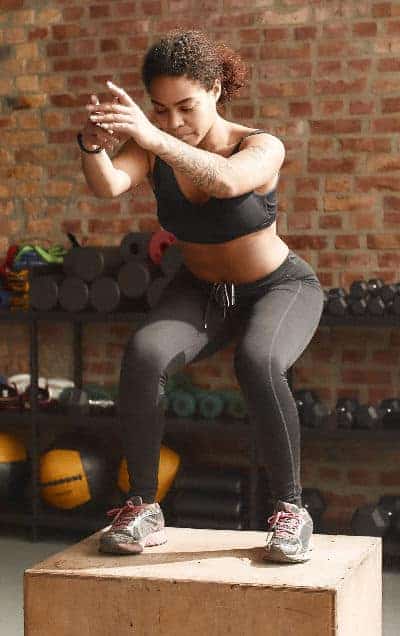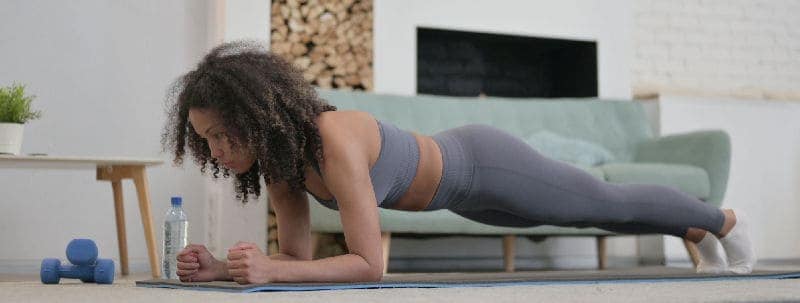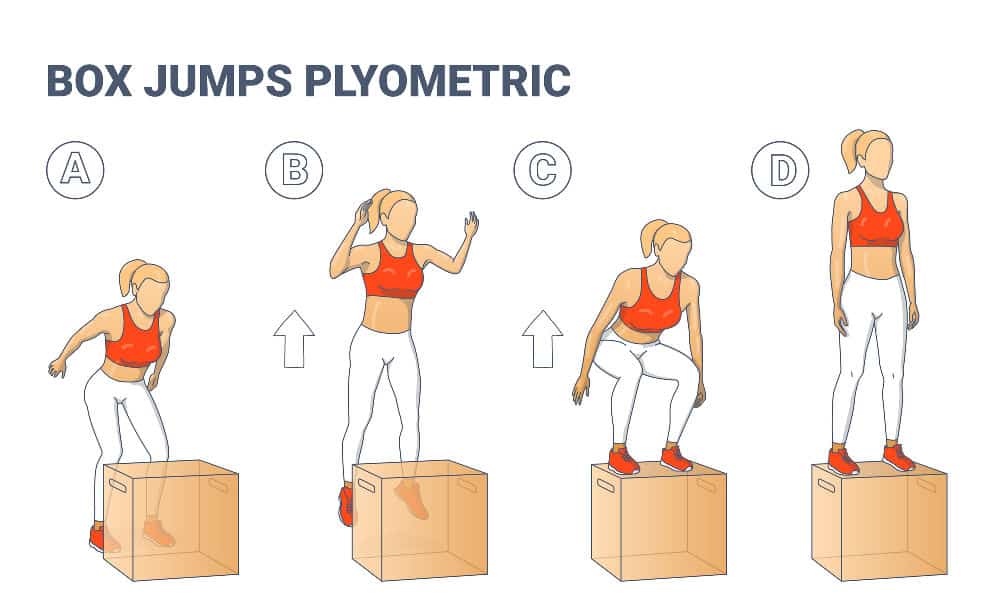If you are looking for the perfect exercises to help increase your speed and power, consider adding plyometrics to your workout routine. Plyometrics has been used by many athletes to improve certain aspects of their sporting performance. This type of training is especially useful to those engaging in sports that require explosiveness.
Continue reading below for a detailed answer to the question, what is plyometric exercise?
What Is The Objective Of Plyometric Exercise?
While plyometrics training is commonly associated with specific sports training performance, just about anyone can use this form of training to boost their power and strength.
In a nutshell, plyometrics can be defined as a type of training that relies on the use of force and speed of different movements to build muscle strength. You can use these exercises to enhance your ability to do various activities or to simply boost your strength and performance.
Jumping, pushups, kicking, running and throwing are among the common plyometrics exercises. This form of training is not only useful to athletes, but can also be used by people who want to improve their physical function or get back into shape after an injury.
However, it is worth noting that plyometrics is a high impact and intense form of training. This means that you should consult your physician first before you start training – especially if you have a physical condition or haven’t been working out for a while.
What Does Plyometrics Improve?
Plyometric exercises target specific muscle groups, including:
Plyometric Leg Exercise: If you choose to engage in this form of physical training, you will be doing a lot of hopping and jumping. As such, you can expect your legs, and leg muscles to be specific, to be doing most of the work.
Plyo Glute Exercises: Plyometric exercises like jump squats target your glutes, helping make them stronger in the process.
Plyometric Arm Workout: Plyometric exercises don’t normally target the arms. However, if you want to work the muscles in your arms, you can go for specific plyometric exercises that target the upper body, such as plyometric pushups and throwing medicine ball exercises.
Types Of Plyometric Exercises
What type of workouts can you expect to get when engaging in plyometric exercise programs?
Plyometrics With Strength Training: As previously mentioned, this form of training is great for building muscle strength and power.
Plyometric Training Develops Flexibility: Since it is based on contracting and stretching your muscles, plyometric training is considered to be great for flexibility.
On the flip side, plyometrics is not great for:
Low Impact Plyometric Workout: This form of training involves a lot of hoping and jumping, meaning that it calls for a high impact workout.
Plyometric Aerobic Exercises: While repeating jumping and hopping actions for anywhere between 30 and 60 seconds is guaranteed to raise your heart rate, plyometrics is not considered to be an aerobic workout.
5 Most Effective Plyometric Exercises
What muscles they work, how to do the exercises
It is highly likely that you have done a few plyometric exercises in the past whether knowingly or not – considering that they are mainly made up of hopping and jumping. As you will see below, the best plyometric exercises do not require any gym equipment or weights. In fact your weight is enough.
This guide on what is plyometric exercise, also covers five of the best plyometric exercises, including:
Plyometric Push-Ups
One of the few plyometric exercises that target the upper body, plyometric pushups are also referred to as clapping pushups. A great exercise for improving your chest and arm speed, power and strength, all you need to do is push hard enough to get your hands off the floor long enough to clap in between reps.
To do this exercise you simply need to:
- Assume a regular plank position
- Lower your body down to the floor to do a regular pushup
- Raise your body upwards, and push hard enough to get your body and hands as high as possible off the ground
- Clap your hands
- Get back to the initial position and repeat the same move for about 30 seconds.
Watch this Push Ups Video
Plyometric Burpee How To
Like the above described exercise, burpees also target your upper body. However, these exercises are more complicated. Fortunately though, they do come with a bigger payoff in terms of fitness. Burpees can be described as a full pushup followed by a jump squat. The last part makes them plyometrics.
Here’s how you do burpees:
- Starting from a standing position, get into a squatting position by bending your knees.
- While keeping your back straight, place your hands on the floor, and jump your feet backwards to get into a plank position.
- Do a pushup by lowering your chest to the floor
- Then come to a squat position by jumping your feet forward to the outside of your hands
- Jump up explosively as you bring your arms over your head
- Do two to three sets of 8 to 12 reps
Watch this Burpee How To Video
Lateral Bounds Workout
This exercise helps you boost your jumping height and speed.
- Assuming a squatting position, balance on your right foot
- Jump explosively as far and as high as you can to the left
- Land in a squat position on your left leg
- Jump explosively as high and far as possible to the right and land in the initial starting position.
- Do three to five sets of five to ten reps.
Watch this Lateral Bounds Video
Plyo Box Jump Exercises
In addition to getting your heart rate up, box jumps normally target your hamstrings, calves, hips, glutes, calves and quads. You can use a box that’s 8 to 36 inches high – depending on your fitness level.
- Starting from a standing position, squat down so as to jump onto the box with both feet
- To gain momentum, lift your arms up as you jump
- Jump up and back, from the box and come down on your feet with both knees bent
- Do two to three sets of eight to twelve reps
Watch this Box Jump Video
Squat Jumps Workout
Targeted at working the muscles in your legs, these exercises are similar to regular squats, with a powerful vertical jump in between each repetition.
- With your feet slightly wider than your feet, assume a standing position
- Get down into a squat
- Jump up explosively, pressing down through your feet and engaging your abdominals
- As you jump, lift your arms over your head
- Get back down into a squatting position as you land
- Do two to three sets of ten reps
- Plyometric Training Program
Watch this Squat Jumps Video
The development of a plyometric training program is normally done consistent with volume and intensity of exercises. Other factors considered in this journey include mastery/level of skill, complexity of movement, exercise progression choice and plane of movement.
Benefits Of Plyometric Exercise
To have a comprehensive understanding of what is plyometric exercise? You will need to know about the benefits – which include:
- Enhanced jumping height
- Faster speed
- Increased muscle power output
- A lower risk of injury to the muscles and joints
- Stronger muscle contractions with reduced consumption of energy
- Improved control when starting and stopping movements
- Enhanced agility – ability to change directions swiftly
- Plyometric Full Body Workout

A number of plyometric exercises are considered to be full body workouts. To get the additional benefit of cardiovascular training, it is recommended that you complete plyometric exercises, one after the other.
Good examples of plyometric full body workouts include, medicine ball slams, burpees, jump squats and tuck jumps.
Plyometric Workout Plan
So, what is plyometric exercise? It simply refers to exercises that use powerful and swift movements to enhance an individual’s power and speed when it comes to performing various actions or motions.
While these exercises are commonly used by athletes, they can also benefit anyone who wants to get into excellent shape. To ensure that you have the best chance of attaining your goals, it is recommended that you enlist the help of a personal trainer who can put together plyometric training sessions that matches your needs.
Hot deals are here! Get gifting with up to 30% off sports & outdoors.

Watch This SideShaper Workout Video

